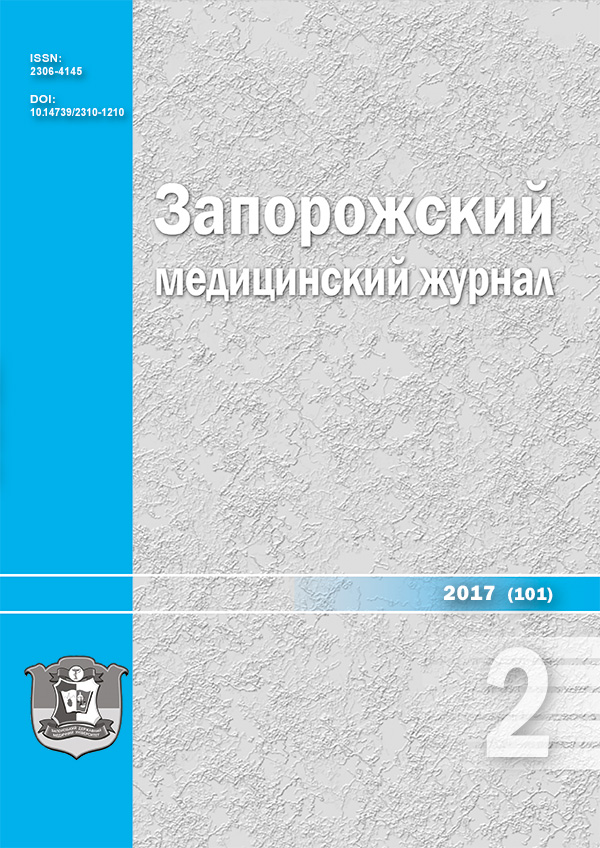Structural reorganization of neurocytes of CA1 field of hippocampus in dynamic after experimental thermal trauma and application of lyophilized xenograft
DOI:
https://doi.org/10.14739/2310-1210.2017.2.95734Keywords:
hippocampus, neurons, burns, lyophilized xenograftsAbstract
The aim of the research was to establish the peculiarities of CA1 field of hippocampus neurocytes structural reorganization of animals in dynamics after experimental thermal injury and use of lyophilized xenograft.
Materials and Methods. In the experiment on 35 mature white male rats microscopic, electronmicroscopic and morphometric study of animals’ hippocampus were made after severe thermal injury in terms of early necrectomy of affected area and closure by lyophilized xenograft. Experimental animals of the third experimental group were decapitated on the 7th, 14th and 21st days of experiment.
Sections of the brain tissue have been taken from the hippocampus area for histological studies, fixed in 96o alcohol and 10 % neutral formalin and embedded in the paraffin blocks. Obtained on microtome sections were stained with hematoxylin and eosin and toluidine blue with Nissl method. Ultrathin sections were contrasted by uranyl acetate and lead citrate according to Reynolds method and were studied in the electron microscope PEM-125K. Morphometric study was performed using system of visual analysis of histological specimens.
Results. It has been established that on the 7th day of the experiment with the usage of corrective factor the number of destroyed neurons in CA1 field of hippocampus was less, but still not significant compared to burned untreated animals. Neurocytes were in state of peripheral or segmental tigrolysis, and there was an increase in the square of hypochromic cells nuclei, some of them contained large nucleoli.
Microscopically and electronmicroscopically on the 14th and especially on the 21st days of the experiment, there was found a significant improvement of histological condition of neurocytes, numerical density of the nerve cells in the CA1 field of hippocampus was significantly 1.25 times higher, and the number of normochromic cells 5.52 times more than in the animals with burns.
Conclusions. Thus, the application of lyophilized xenograft after early necrectomy of burned skin earlier (the 7th day of experiment) after burn injury prevents deep changes of hippocampus CA1 field neurocytes, reduces the number of damaged cells.
The positive impact of lyophilized xenograft application is the most expressive at the later stages after burn (the 14th and the 21st days of the experiment). Histologically there is a relative normalization of microscopic and ultrastructural composition of neurocytes, improvement in indices of density and proportion of nerve cells different types in the CA1 field of the hippocampus.
References
Net’ukhaylo, L. G., Kharchenko, S. V., & Kostenko, A. G. (2011). Patohenez opikovoi khvoroby (chastyna I) [Pathogenesis of the burn disease]. Svit medytsyny ta biolohii, 1, 127–135. [in Ukrainian].
Volkov, K. S. (1995). Morfolohichni zminy hipotalamo-neirohipofizarnoi systemy pry opikovii travmi i pislia zastosuvannia antyoksydantiv ta enterosorbentiv (Dis… dokt. biol. nauk). [Morphological changes of the hypothalamic-neurohypophysis system after burn injuries under the use of antioxidants and enterosorbents. Dr. biol. sci. diss.]. Kyiv: Poligrafist. [in Ukrainian].
Otmakhov, N. A. (1993). Nejronalʹnaya setʹ gippokampa: morfologicheskij analiz [Neuronal network of the hippocampus: morphological analysis]. Uspekhi fiziologicheskoj nauki, 4, 79–101. [in Russian].
Kennedy, S. (2016). Psychosocial Stress, Health, and the Hippocampus. J. Undergrad. Neurosci. Educ., 15 (1), 12–13.
Bihuniak, V. V., Povstianyi, M. Yu., & Volkov, K. S. (2003). Vykorystannia liofilizovanykh ksenodermotransplantativ u kombustiolohii [Usage lyophilized xenografts in combustiology]. Ternopil: Ukrmedknyha. [in Ukrainian].
Nahaichuk, V. I. (2010). Suchasni pidkhody do nadannia dopomohy khvorym z opikamy [Modern approaches to providing care to patients with burns]. Mystetstvo likuvannia, 5, 24–27. [in Ukrainian].
Kramar, S. B., & Volkov, K. S. (2015). Ulʹtrastrukturnye izmeneniya ozhogovoj rany v usloviyyakh primeneniya kriolofilizirovanogo ksenodermalʹnogo substrata posle éksperimentalʹnoj termicheskoj travmy [Ultrastructural changes of burn wound after experimental thermal trauma and application of lyophilized xenographt substrate]. Problemy biolohii i medytsyny, 84 (3), 164–170. [in Uzbekistan].
Nebesna, Z. M., Volkov, K. S., & Andriyishyn, O. P. (2015). Peculiarities of course of structural and histochemical changes of lungs under experimental thermal injury and application of lyophilized xenographt substrate. Nauka i studia, 141 (10), 5–11. [in Poland].
Viter, V. S., & Volkov, K. S. (2014). Ultrastructural state of muscular tunic of the heart after experimental thermal injury in applying lyophilized xenografts. Nauka i studia, 118(8), 107–111. [in Poland].
Valenzuela, V., Oñate, M., Hetz, C., & Court, F. A. (2016). Injury to the nervous system: A look into the ER. Brain Res., 1648, 617–625. doi: 10.1016/j.brainres.2016.04.053.
Skybo, H. H., Kovalenko, T. M., Osadchenko, I. O.,Tsupykov, O. M., & Pivneva, T. A. (2006). Ctrukturni zminy v hipokampi pry eksperymentalnii ishemii mozku [Structural changes in the hippocampus in experimental brain ischemia]. Ukrainskyi nevrolohichnyi zhurnal, 4, 38–44.
Zhang, Q. H., Li, J. C., Dong, N., Tang, L. M., Zhu, X. M., Sheng, Z. Y., & Yao, Y. M. (2013). Burn injury induces gelsolin expression and cleavage in the brain of mice. Neuroscience, 3, 60–72. doi: 10.1016/j.neuroscience.2012.10.013.
Horalskyi, L. P., Khomych, V. T., & Kononskyi, O. I. (2011). Osnovy histolohichnoi tekhniky i morfofunktsionalni metody doslidzhen u normi ta pry patolohii [Histological techniques and methods of morphological studies in normal and pathological conditions]. Zhytomyr: Polissia.
Downloads
How to Cite
Issue
Section
License
Authors who publish with this journal agree to the following terms:
Authors retain copyright and grant the journal right of first publication with the work simultaneously licensed under a Creative Commons Attribution License that allows others to share the work with an acknowledgement of the work's authorship and initial publication in this journal. 
Authors are able to enter into separate, additional contractual arrangements for the non-exclusive distribution of the journal's published version of the work (e.g., post it to an institutional repository or publish it in a book), with an acknowledgement of its initial publication in this journal.
Authors are permitted and encouraged to post their work online (e.g., in institutional repositories or on their website) prior to and during the submission process, as it can lead to productive exchanges, as well as earlier and greater citation of published work (See The Effect of Open Access)

